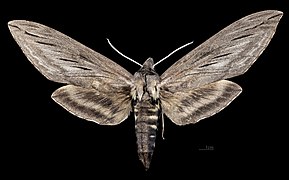Sphinx chersis
| Sphinx chersis | ||||||||||||
|---|---|---|---|---|---|---|---|---|---|---|---|---|

Sphinx chersis |
||||||||||||
| Systematics | ||||||||||||
|
||||||||||||
| Scientific name | ||||||||||||
| Sphinx chersis | ||||||||||||
| Huebner , 1823 |
Sphinx Chersis is a butterfly ( moth ) from the family of moth (Sphingidae). The species is one of the best-studied swarms.
features
The moths have a fore wing length of 38 to 55 millimeters. In the east of their distribution they can be easily distinguished from other species of the genus Sphinx by their size, the more or less monochrome gray to blue-gray forewings with the weakly developed, pale white-black markings . The outermost of the black lines reaches the wing tip. The upper surface of the hind wings is black with faded, pale gray bands. In the southwest one can confuse the species with Sphinx asellus , which is, however, somewhat smaller. In addition, the underside of the wings in Sphinx chersis is clearly patterned, while the pattern is reduced in the similar species. The two species cannot be clearly differentiated from one another on the basis of the upper sides, the pale white band on the forewings at the outer edge of the black lines tends to be wider in the similar species than in Sphinx chersis . The thorax of Sphinx chersis has a single pair of fine black lines running lengthways along the inner margin, while Sphinx asellus has two pairs, although the second pair can be very fine. The gnathos of the male genitalia is slightly notched in Sphinx chersis , in the similar species it is broadly rounded. The coloring of the moths is practically not variable. Individuals from California tend to be slightly smaller than those in the rest of the range. Other similar species are Sphinx perelegans and Sphinx vashti . The former has a dark upper side of the thorax with black stripes that lead back to the abdomen, the latter lacks the piebald border on the hind wings.
The caterpillars are very pale straw yellow in the first stage and have a dark anal horn that clearly ends in two points. The adult caterpillars have the typical appearance of hawk caterpillars. They have seven pairs of diagonal strips and a conspicuous anal horn on the sides. Their basic color is light blue-green, with the back being lighter yellowish-green. But there are also reddish colored caterpillars. The clearly developed white diagonal stripes on the sides have dark blue-green to purple borders towards the back. The anal horn is blue-green with a red tinge at the tip. The head has a pair of yellow stripes on the sides that meet at the top. In particular, the first three segments of the caterpillars have a grainy structure. These segments are also colored darker green or less intensely blue-green.
The pupa is reddish brown and has a fairly smooth, shiny surface. A pair of glossy black, chitinized notches can be seen near the stigmas of the sixth and seventh abdomen segments. These notches are not known from any other species of the genus. The rather short Kremaster tapers sharply towards the top to a double point.
Occurrence
The very common species is found in much of southern Canada and the United States with the exception of the most southeastern states and Mexico. To the east, the species is known from Nova Scotia, southern Québec, and much of Ontario. East of the Great Plains, the species is more common in the north, but evidence is rarer towards the south. There is no evidence for South Carolina, Georgia, Alabama, Mississippi, and Louisiana. Evidence from Florida is also very likely false reports. A single specimen from Thornhill in Manitoba has been recorded in the west, but the species occurs in southern Saskatchewan and occasionally in southeastern Alberta. In the western United States, with the exception of Wyoming and Idaho, the species has been found everywhere, although this lack is probably due to insufficient documentation.
Sphinx chersis is more common in wooded areas and prefers microhabitats with sufficient moisture for ash growth.
Way of life
The moths hatch in the late afternoon and become active the first evening. They often fly towards light sources and nectar blossoms at night. They have been found, for example, in evening primrose ( Oenothera ), Virginian tobacco ( Nicotiana tabacum ), Lonicera japonica , common soapwort ( Saponaria officinalis ), Apocynum , marsh silk plants ( Asclepias incarnata ) and cultivated petunias ( Petunia x hybrida ).
Flight and caterpillar times
The moths fly in the north of their distribution in one generation from late May to early July. In the south, they fly in two generations from early May to September.
Food of the caterpillars
The caterpillars feed mainly on ash trees ( Fraxinus ), but also other species of the olive family (Oleaceae) such as common lilac ( Syringa vulgaris ), Chionanthus virginicus and privet ( Ligustrum ). The species has also been found in rose plants (Rosaceae) such as Prunus species and poplars ( Populus ) from the willow family (Salicaceae).
development
The females lay their eggs one by one on the host plants. The diurnal caterpillars are loners. They rest on the underside of the leaf on the midrib. Pupation takes place in a chamber several centimeters deep in the ground.
supporting documents
Individual evidence
- ↑ a b c d e f g h i j k l James P. Tuttle: The Hawkmoths of North America, A Natural History Study of the Sphingidae of the United States and Canada. The Wedge Entomological Research Foundation, Washington, DC 2007, ISBN 978-0-9796633-0-7 .
- ↑ a b c d e Sphingidae of the Americas. Bill Oehlke, accessed December 29, 2011 .
literature
- James P. Tuttle: The Hawkmoths of North America, A Natural History Study of the Sphingidae of the United States and Canada. The Wedge Entomological Research Foundation, Washington, DC 2007, ISBN 978-0-9796633-0-7 .




